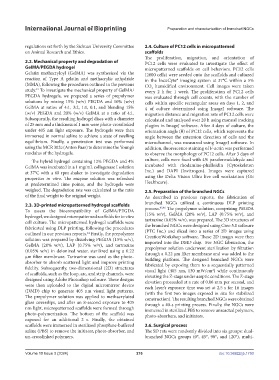Page 224 - IJB-10-3
P. 224
International Journal of Bioprinting Preparation and characterization of branched NGCs
regulations set forth by the Sichuan University Committee 2.4. Culture of PC12 cells in micropatterned
on Animal Research and Ethics. scaffolds
The proliferation, migration, and orientation of
2.2. Mechanical property and degradation of PC12 cells were evaluated to investigate the effect of
GelMA/PEGDA hydrogel micropatterned scaffolds on cell behaviors. PC12 cells
Gelatin methacryloyl (GelMA) was synthesized via the (2000 cells) were seeded onto the scaffolds and cultured
reaction of Type A gelatin and methacrylic anhydride in the IncuCyte® imaging system at 37℃ within a 5%
(MMA), following the procedures outlined in the previous CO humidified environment. Cell images were taken
2
study. To investigate the mechanical property of GelMA/ every 2 h for 1 week. The proliferation of PC12 cells
43
PEGDA hydrogels, we prepared a series of prepolymer was evaluated through cell counts, with the number of
solutions by mixing 15% (w/v) PEGDA and 10% (w/v) cells within specific rectangular areas on days 1, 2, and
GelMA at ratios of 4:1, 3:2, 1:1, 0:1, and blending 15% 4 of culture determined using ImageJ software. The
(w/v) PEGDA and 20% (w/v) GelMA at a ratio of 4:1. migration distance and migration rate of PC12 cells were
Subsequently, the resulting hydrogel discs with a diameter calculated and analyzed over 20 h using manual tracking
of 25 mm and a thickness of 1 mm were photo-crosslinked plugins in ImageJ software. After 4 days of culture, the
under 405 nm light exposure. The hydrogels were then orientation angle (θ) of PC12 cells, which represents the
immersed in normal saline to achieve a state of swelling angle between the extension direction of cells and the
equilibrium. Finally, a penetration test was performed microchannel, was measured using ImageJ software. In
using the MCR 302e (Anton Paar) to determine the Young’s addition, fluorescence staining of F-actin was performed
modulus of the hydrogels. to observe the morphology of PC12 cells. After 3 days of
The hybrid hydrogel containing 12% PEGDA and 4% culture, cells were fixed with 4% paraformaldehyde and
GelMA was incubated in a 1 mg/mL collagenase I solution incubated with rhodamine-phalloidin (Cytoskeleton
at 37℃ with a 60 rpm shaker to investigate degradation Inc.) and DAPI (Invitrogen). Images were captured
properties in vitro. The enzyme solution was refreshed using the Delta Vision Ultra live cell workstation (GE
at predetermined time points, and the hydrogels were Healthcare).
weighed. The degradation rate was calculated as the ratio 2.5. Preparation of the branched NGCs
of the final weight to the original weight. As described in previous reports, the fabrication of
2.3. 3D-printed micropatterned hydrogel scaffolds branched NGCs utilized a continuous DLP printing
45,46
To assess the biocompatibility of GelMA/PEGDA process. The prepolymer solution, comprising PEGDA
hydrogel, we designed micropatterned scaffolds for in vitro (15% w/v), GelMA (20% w/v), LAP (0.75% w/v), and
tartrazine (0.05% w/v), was prepared. The 3D structures of
cell culture. The micropatterned hydrogel scaffolds were the branched NGCs were designed using Creo 5.0 software
fabricated using DLP printing, following the procedures (PTC Inc.) and sliced into a series of 2D images using
outlined in our previous reports. Firstly, the prepolymer CreationWorkshop software. These 2D images were then
44
solution was prepared by dissolving PEGDA (15% w/v),
GelMA (20% w/v), LAP (0.75% w/v), and tartrazine imported into the DMD chip. For NGC fabrication, the
(0.05% w/v) in deionized water, sterilized using a 0.22 prepolymer solution underwent sterilization by filtration
μm filter membrane. Tartrazine was used as the photo- through a 0.22 μm filter membrane and was added to the
building platform. The designed branched NGCs were
absorber to absorb scattered light and improve printing fabricated by exposing them to a sequentially patterned
fidelity. Subsequently, two-dimensional (2D) structures visual light (405 nm, 130 mW/cm ) while continuously
2
of scaffolds, such as the loop, arc, and strip channels, were elevating the Z-stage under aseptic conditions. The Z-stage
designed using Adobe Photoshop software. These designs elevation proceeded at a rate of 0.06 mm per second, and
were then uploaded to the digital micromirror device each layer’s exposure time was set at 2.5 s for 16 images
(DMD) chip to generate 405 nm visual light patterns. (with the first two images exposed in situ for stabilized
The prepolymer solution was applied to methacrylated construction). The resulting branched NGCs were obtained
glass coverslips, and after an 8-second exposure to 405 through a 40-s printing process. Finally, the NGCs were
nm light, micropatterned scaffolds were formed through immersed in sterilized PBS to remove unreacted polymers,
photo-polymerization. The bottom of the scaffold was photo-absorbers, and initiators.
exposed for an additional 2 s. Finally, the obtained
scaffolds were immersed in sterilized phosphate-buffered 2.6. Surgical process
saline (PBS) to remove the initiator, photo-absorber, and The SD rats were randomly divided into six groups: dual-
un-crosslinked polymers. branched NGCs groups (0°, 45°, 90°, and 120°), multi-
Volume 10 Issue 3 (2024) 216 doi: 10.36922/ijb.1750

